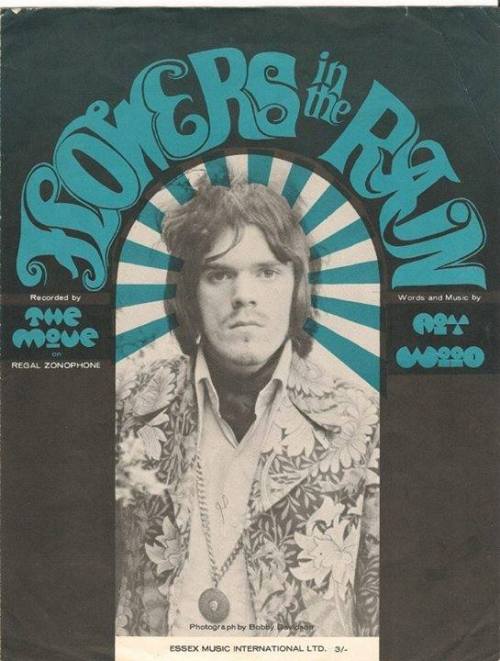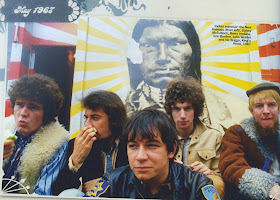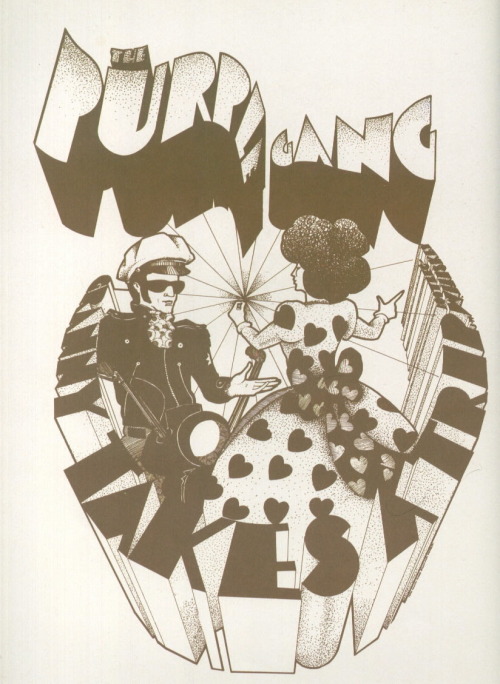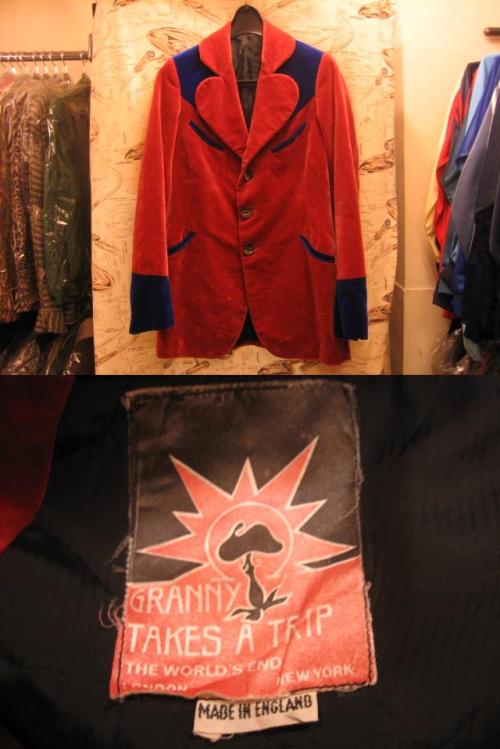Nigel Weymouth (right) outside Granny's in 1966
1967
1968
1969
The interiors of the shop were painted purple and decorated with Aubrey Beardsley's erotic prints. The was a heavy scent of incense in the air. The overall effect was supposed to be intimidating for customers who were not a part of an 'In' crowd. And so were the prices. The high prices at Granny's were determined by the use of expensive fabrics. Weymouth and Pearse were buying Liberty fabrics at retail prices and they were using the same outworkers as Savile Row tailors. As a result, shirts from Granny's were prized at anything between 4 to 10 guineas. A floral jacket inspired by William Morris designs would set a buyer back an extortionate 15 guineas. Skinny trousers made out of velvet or satin ("They were sort of more foppish alternative to levi's" - John Pearse(Decharne, 182)) would cost 6 guineas, and satin ties were priced at £1.10. However, the quality of the clothes was very good and John Pearse was putting a lot of emphasis on fine tailoring. Velvet suits were tightly-fitting with tight buttoning. Double - breasted jackets were tailored in floral-printed fabrics. One of the sales assistants, Johnny Moke remembers: "We used to cut up blouses and dresses and turn them into shirts or tops for men. What was great about Granny's was that there were no boundaries. Anything went and they kept on changing"(Paul Gorman. The Look - Adventures in Rock and Pop Fashion, p 78).The effect of Granny's clothes was foppish, flamboyant and decadent - a 1960's reinvention on fin-de siecle dandyism.
Probably the most iconic garment made by Granny Takes a Trip - William Morris chrysantenum print jacket as worn by John Lennon...
Jess Down, Rufus Potts Dawson, Nigel Weymouth (wearing William Morris chrysantemum pattern jacket) and future disco queen Amanda Lear, 1967
George Harrison wearing William Morris Golden Lily pattern jacket from GTAT, May 1968
Nigel Lesmoir-Gordon, 1967
Granny Takes a Trip jacket from 1967. It is made of William Morris 'bachelor's button' pattern, which was first produced by Morris & Co. in 1892.
Granny Takes a Trip quickly developed elite clientele. Nigel Weymouth says: " The first people to sniff us out were the mixture of Chelsea gays and debutantes(...) Then pop stars started quickly coming after them. We had all these personalities coming through, and groups like the Animals would have their photos taken outside".
The Animals outside Granny Takes a Trip, 1967
Julie Driscoll outside Granny Takes a Trip, 1967
Short promotional film for a single "Granny Takes a Trip" by The Purple Gang from 1967. The song title was supposed be an ad for a boutique.
Promotional poster for the single by Michael English (1967)
The Purple Gang outside Granny's , 1967
John Pearse also points out that: "We were the first bisexual shop, if you like - We had woman's clothes big time, frocks and blouses, and there was no hard sale because everyone knew everyone else"(Gorman, p 76). One of the female clients of Granny Takes a Trip, actress and model Anita Pallenberg remembers: "If I wore mini-skirts, I'd have them made by Granny's. We'd try on clothes and have a joint in the back. Granny's was very small, just two rooms, so everyone knew each other" (Mojo Classic, vol.2, issue 4, 2007, p59).
Plan of the interior of Granny's in London Magazine, October 1966.
Actress Linda Thorson in Granny Takes a Trip, 1967
This is how another famous customer - Salman Rushdie, remembers interior of Granny's: The air was very heavy with incense and patchouli oil and also the aromas of what the police called Certain Substances. Psychedelic music, big on feedback, terrorised your eardrums. After a time you became aware of a low purple glow, in which you could make out a few motionless shapes. These probably were clothes, probably for sale. You didn't like to ask. Granny's was a pretty scary place (Gorman, 79).
Jacket from Granny Takes a Trip in a collection of Metropolitan Museum in New York
Jackets from Freddie Hornick-era Granny - early 1970's ( via Freakshow)
Velvet 'Western' jacket from Granny takes a Trip
Customer being fitted for red and black velvet 'western' jacket at Granny's, circa 1971
Velvet 'panel' jacket from Granny Takes a Trip, around 1971
Green velvet jacket with worn by Keith Richards, from around 1971
Dress from Granny's from around 1967 as worn by Jane Asher
Poster by Nigel Weymouth advertising Granny Takes a Trip, circa 1967
Article about council - ordered removal of famous half-Dodge, 1969
The relaxed atmosphere was one of the attractions of Granny's. Anybody who was rich enough to shop there - young upper middle class men, young aristocrats and pop stars (Such as The Rolling Stones who wore clothes from Granny Takes a Trip on the cover of their 1967 album Between The Buttons, or The Beatles who wore Granny's shirts in the photo on the inner sleeve of Revolver ) enjoyed buying fancy clothes in the casual atmosphere of the boutique which epitomized Swinging London as a fashion epicentre in the 1960's. Granny's initiall success, however started losing its momentum by 1969. When Granny started selling Afghan coats, there was a row between Pearse and Weymouth over the priorities of their business establishment. Pearse did not like the increasingly hippy image of the shop: "My partners went more in that direction, but I was considered to be more urban creature(...) I never wore jeans (...) I was always more streamlined in my appearance. We may have been construed as being in the centre of hippydom, but we weren't; what we did had a subtle difference"(Gorman,p 80). Weymouth's involvement with Hapshash and the Colored Coat as a designer caused his gradual withdrawal from shop's affairs. Weymouth, Pearse and Cohen ended up selling the shop to manager Freddie Hornick (who previously co-managed Dandie Fashions boutique with Alan Holston) in 1969.
Press profile of Freddie Hornick
Hornick's arrival provided much needed shot of fresh energy and ideas. He brought in two American managers - Gene Krell and Marty Breslau. Krell had a tailoring experience, and Breslau took care of a business side. Under their directorship, rejuvenated Granny Takes a Trip has become a mecca for rock stars - by early 1970's clientele of Granny Takes a Trip included Paul McCartney, Gram Parsons, Robert Plant, Elton John, Eric Clapton, Miles Davis, David Bowie, Marc Bolan and Rod Stewart. And that's just for starters...
Glam Rock-style jacket from Granny Takes A Trip (via Freakshow)
Gold and black lurex suit made for Marc Bolan (now in V&A collection), 1971
The Faces on TOTP in 1971, Rod Stewart is wearing a Granny takes a Trip jacket
Rod Stewart wearing leopard print suit from Granny Takes a Trip, 1972
Roger Taylor from Queen wearing velvet western jacket from Granny Takes a Trip circa 1973
Velvet trousers from Granny Takes a Trip worn by Keith Richards around 1971
Jacket from Granny Takes a Trip. Model unknown (or is it Steve Peregrine Took?) .
Granny Takes a Trip in early 1970's
Boots from Granny Takes a Trip, early 1970's
Keith Richards wearing snakeskin boots from Granny Takes a Trip, 1969
Hornick opened highly successful branches of the boutique in New York and Los
Angeles.
Granny Takes a Trip on Doheny Drive in Los Angeles, which opened in 1972
Granny Takes a Trip after the move to Sunset Boulevard in Los Angeles circa 1974
Paul Raymond outside LA branch of GTAT, circa 1973
Granny Takes a Trip and its American branches enjoyed great success and continued to cater to the young and hip until late 1970's.
Granny Takes a Trip became a legendary boutique that defined King's Road of the 60's.Original garments from Granny's - especially from Pearse-Cohen-Weymouth era, are highly sought vintage items which often reach prices of thousands of pounds.
Royal Mail stamp from 2012, commemorating contribution to British fashion by designers from Granny Takes a Trip.
As far as the original founders of Granny's are concerned, two of them are still around. Weymouth is a graphic artist living in Los Angeles. John Pearse had left tailoring in the 1970's but came back to it in the mid-1980's. He opened his own shop in Soho, and today is one of the most successful London tailors. One of his most famous clients (as well as his Meard Street neighbour) was (recently deceased) artist, writer and dandy Sebastian Horsley
Sheila Cohen has not been in touch with her former partners for years and her whereabouts are unknown.
Sadly, Freddie Hornick passed away in 2009.
Photos used here come from personal collection of Roger Klein (former employee and manager of LA branch of Granny's) who shared them via Granny Takes a Trip Facebook fan page.
Sadly, Freddie Hornick passed away in 2009.
Photos used here come from personal collection of Roger Klein (former employee and manager of LA branch of Granny's) who shared them via Granny Takes a Trip Facebook fan page.
























































i really have to say i love your blog, haven´t found so many great pictures and information of my favourite decade so far on any other blog!!! so i can´t wait to read more of your posts;)
ReplyDeletelove and kiss,mary
http://maryloucinnamon.blogspot.com/
<<<<<<<<<<<<<<<<<<<< THE LOW PARK OF HIGH HEELED BOYS >>>>>>>>>>>>>>>>>>>>
ReplyDeleteGlad to have been part of those glorious heady days in London between 1969
and 1972 when the world was our oyster and this city was our canvas .
Granny's - Chelsea Cobbler - Sweenies - 232 - Rainbow - Bibas -
Ruskins - Round House - Costa's - Kensington Market - Parsons
Pheasantry - Picasso - Speakeasy - Hyse Park - Blow Up .
The greatest days of my life - Memories I will never forget .
I used to own the "Velvet 'panel' jacket from Granny Takes a Trip, around 1971."
ReplyDeleteIt had the purple tag and was more likely from 68 or 69. :)